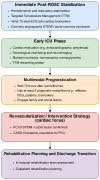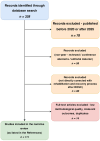Current Perspectives on Rehabilitation Following Return of Spontaneous Circulation After Sudden Cardiac Arrest: A Narrative Review
- PMID: 40805898
- PMCID: PMC12345673
- DOI: 10.3390/healthcare13151865
Current Perspectives on Rehabilitation Following Return of Spontaneous Circulation After Sudden Cardiac Arrest: A Narrative Review
Abstract
Background/Objectives: Sudden cardiac arrest (SCA) is a major global health concern with high mortality despite advances in resuscitation techniques. Achieving return of spontaneous circulation (ROSC) represents merely the initial step in the extensive rehabilitation journey. This review highlights the critical role of structured, multidisciplinary rehabilitation following ROSC, emphasizing the necessity of integrated physiotherapy, neurocognitive therapy, and psychosocial support to enhance quality of life and societal reintegration in survivors. Methods: This narrative review analyzed peer-reviewed literature from 2020-2025, sourced from databases such as PubMed, Scopus, Web of Science, and Google Scholar. Emphasis was on clinical trials, expert guidelines (e.g., European Resuscitation Council 2021, American Heart Association 2020), and high-impact journals, with systematic thematic analysis across rehabilitation phases. Results: The review confirms rehabilitation as essential in addressing Intensive Care Unit-acquired weakness, cognitive impairment, and post-intensive care syndrome. Early rehabilitation (0-7 days post-ROSC), focusing on parameter-guided mobilization and cognitive stimulation, significantly improves functional outcomes. Structured interdisciplinary interventions encompassing cardiopulmonary, neuromuscular, and cognitive domains effectively mitigate long-term disability, facilitating return to daily activities and employment. However, access disparities and insufficient randomized controlled trials limit evidence-based standardization. Discussion: Optimal recovery after SCA necessitates early and continuous interdisciplinary engagement, tailored to individual physiological and cognitive profiles. Persistent cognitive fatigue, executive dysfunction, and emotional instability remain significant barriers, underscoring the need for holistic and sustained rehabilitative approaches. Conclusions: Comprehensive, individualized rehabilitation following cardiac arrest is not supplementary but fundamental to meaningful recovery. Emphasizing early mobilization, neurocognitive therapy, family involvement, and structured social reintegration pathways is crucial. Addressing healthcare disparities and investing in rigorous randomized trials are imperative to achieving standardized, equitable, and outcome-oriented rehabilitation services globally.
Keywords: ROSC; SCA; early mobilization; functional recovery; neurocognitive recovery; post-cardiac arrest rehabilitation.
Conflict of interest statement
The authors declare no conflicts of interest.
Figures



Similar articles
-
Prescription of Controlled Substances: Benefits and Risks.2025 Jul 6. In: StatPearls [Internet]. Treasure Island (FL): StatPearls Publishing; 2025 Jan–. 2025 Jul 6. In: StatPearls [Internet]. Treasure Island (FL): StatPearls Publishing; 2025 Jan–. PMID: 30726003 Free Books & Documents.
-
Exercise rehabilitation following intensive care unit discharge for recovery from critical illness.Cochrane Database Syst Rev. 2015 Jun 22;2015(6):CD008632. doi: 10.1002/14651858.CD008632.pub2. Cochrane Database Syst Rev. 2015. PMID: 26098746 Free PMC article.
-
Cardiopulmonary resuscitation (CPR) plus delayed defibrillation versus immediate defibrillation for out-of-hospital cardiac arrest.Cochrane Database Syst Rev. 2014 Sep 12;2014(9):CD009803. doi: 10.1002/14651858.CD009803.pub2. Cochrane Database Syst Rev. 2014. PMID: 25212112 Free PMC article.
-
The effectiveness of interventions to meet family needs of critically ill patients in an adult intensive care unit: a systematic review update.JBI Database System Rev Implement Rep. 2016 Mar;14(3):181-234. doi: 10.11124/JBISRIR-2016-2477. JBI Database System Rev Implement Rep. 2016. PMID: 27532144
-
Continuous chest compression versus interrupted chest compression for cardiopulmonary resuscitation of non-asphyxial out-of-hospital cardiac arrest.Cochrane Database Syst Rev. 2017 Mar 27;3(3):CD010134. doi: 10.1002/14651858.CD010134.pub2. Cochrane Database Syst Rev. 2017. PMID: 28349529 Free PMC article.
References
-
- Nolan J.P., Sandroni C., Böttiger B.W., Cariou A., Cronberg T., Friberg H., Genbrugge C., Haywood K., Lilja G., Moulaert V.R.M.M., et al. European Resuscitation Council and European Society of Intensive Care Medicine guidelines 2021: Post-resuscitation care. Resuscitation. 2021;16:220–269. doi: 10.1016/j.resuscitation.2021.02.012. - DOI - PubMed
-
- Gräsner J.-T., Herlitz J., Tjelmeland I.B., Wnent J., Masterson S., Lilja G., Bein B., Böttiger B.W., Rosell-Ortiz F., Nolan J.P., et al. European Resuscitation Council Guidelines 2021: Epidemiology of cardiac arrest in Europe. Resuscitation. 2021;161:61–79. doi: 10.1016/j.resuscitation.2021.02.007. - DOI - PubMed
-
- Perkins G.D., Neumar R., Monsieurs K.G., Lim S.H., Castren M., Nolan J.P., Nadkarni V., Montgomery B., Steen P., Cummins R., et al. The International Liaison Committee on Resuscitation—Review of the last 25 years and vision for the future. Resuscitation. 2017;121:104–116. doi: 10.1016/j.resuscitation.2017.09.029. - DOI - PubMed
Publication types
Grants and funding
LinkOut - more resources
Full Text Sources

